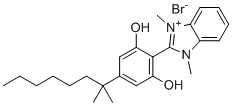
AM9405
CAS No. ——
AM9405( AM-9405 | GAT379 | GAT-379 )
Catalog No. M17035 CAS No. ——
AM9405 (AM-9405, GAT-379) is novel potent, peripherally active cannabinoid type 1 (CB1) and 5-HT3 receptor agonist.
Purity : >98% (HPLC)
 COA
COA
 Datasheet
Datasheet
 HNMR
HNMR
 HPLC
HPLC
 MSDS
MSDS
 Handing Instructions
Handing Instructions
| Size | Price / USD | Stock | Quantity |
| 100MG | Get Quote | Get Quote |


|
| 200MG | Get Quote | Get Quote |


|
| 500MG | Get Quote | Get Quote |


|
| 1G | Get Quote | Get Quote |


|
Biological Information
-
Product NameAM9405
-
NoteResearch use only, not for human use.
-
Brief DescriptionAM9405 (AM-9405, GAT-379) is novel potent, peripherally active cannabinoid type 1 (CB1) and 5-HT3 receptor agonist.
-
DescriptionAM9405 (AM-9405, GAT-379) is novel potent, peripherally active cannabinoid type 1 (CB1) and 5-HT3 receptor agonist, inhibits the EFS-induced twitch contraction of the ileum and the colon with IC50 of 0.076 and 45.71 nM, respectively; significantly slows mouse intestinal motility in physiological conditions, reverses hypermotility and reduced pain in mouse models mimicking symptoms of functional GI disorders, such as stress-induced diarrhea and writhing test.
-
In Vitro——
-
In Vivo——
-
SynonymsAM-9405 | GAT379 | GAT-379
-
PathwayGPCR/G Protein
-
TargetCannabinoid Receptor
-
RecptorCannabinoid Receptor
-
Research Area——
-
Indication——
Chemical Information
-
CAS Number——
-
Formula Weight461.444
-
Molecular FormulaC24H33BrN2O2
-
Purity>98% (HPLC)
-
Solubility——
-
SMILES——
-
Chemical Name2-(2,6-dihydroxy-4-(2-methyloctan-2-yl)phenyl)-1,3-dimethyl-1H-benzo[d]imidazol-3-ium bromide
Shipping & Storage Information
-
Storage(-20℃)
-
ShippingWith Ice Pack
-
Stability≥ 2 years
Reference
1. Salaga M, et al. Eur J Pharmacol. 2018 Aug 17;836:34-43.
molnova catalog



related products
-
Pregnenolone acetate
Pregnenolone acetate is a powerful neurosteroid, the main precursor of various steroid hormones including steroid ketones.?
-
Hemopressin (rat)
Bioactive endogenous peptide substrate for endopeptidase 24.15 (ep24.15), neurolysin (ep24.16) and ACE. Ki values are 27.76, 3.43 and 1.87 μM respectively. Potent hypotensive in vivo. Also acts as a selective CB1 receptor inverse agonist. Displays antinociceptive activity and induces hypophagia in vivo.
-
CP-724714
CP-724714 is an effective and selective HER2/ErbB2 inhibitor (IC50: 10 nM), >640-fold selectivity against EGFR, Abl, InsR, PDGFR, IRG-1R, Src, VEGFR2, c-Met etc.



 Cart
Cart
 sales@molnova.com
sales@molnova.com


